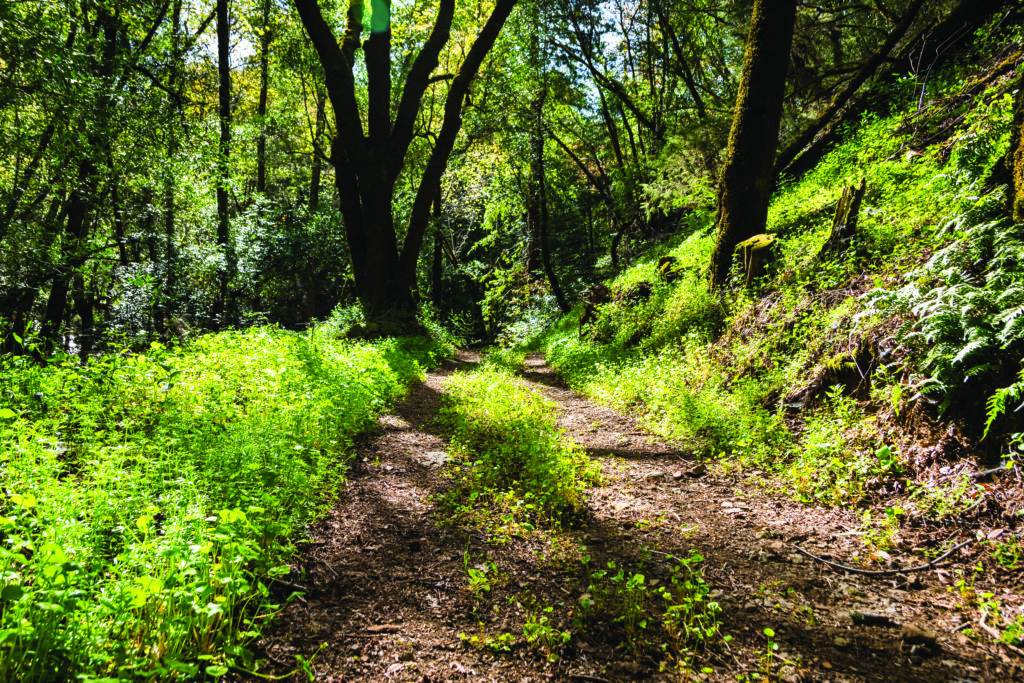Finding Goodness in the Ground
Foraging is free, fun, and a conscious local way to nourish oneself. We are blessed to live in California where we are privileged with an exceptional abundance of tasty trees and wild weeds aboveground and a mystical mycelium web below. Year-round easy pickings include native sweet grass, yerba santa, coyote mint, angelica, milkmaids, madrone, hazelnut, acorn, pine, bay tree, and a variety of delicious berries (including blackberry, huckleberry, elderberry, strawberry, thimbleberry, bearberry, and the “little apples” known as manzanita). To be a respectful forager, never pick more than a quarter of what you find. This leaves ample for birds, animals and insects, as well as for the plant itself to regenerate.
After the winter rains we can expect a bounty of wonderful weeds and leafy greens. Miner’s lettuce (claytonia perfoliata) is an abundant native superfood known to occupy eroding slopes. It got its name from Gold Rush era prospectors who readily feasted on the lettuce and thus averted scurvy. Forager’s tip: Look for miner’s lettuce in clay-rich soil near fire roads and adjacent to other delightful edibles such as chickweed, cleavers (sticky grass). and plantain. Throw them all together into a salad with redwood sorrel (sour grass) for zest. This succulent snack will help immunize you against the common cold.
Some of my favorite sacred herbs to forage are the magical mugwort (artemisia douglasiana) and the coastal/sierra sagebrush (artemisia californica/tridentata). Named after Artemis, the Greek goddess of the moon, this family of herbs, when burned, drunk, or placed under a pillow, will enhance your sleep and elicit lucid vivid dreams. Known as “black sage” (although not officially part of the sage (salvia spp.) family), they can be made into potent dream pillows, smudge sticks, and medicinal teas. Forager’s tip: Artemisias become a remedy for poison oak when you apply their juice over the rash to relieve that itchy witchy curse.

Mugwort almost always grows near a water source and its young leaves make a delicious tea that can be sweetened with “good herb” yerba buena. The aged leaves can be used to make moxa, an acupuncture smudge stick. Known also as “sailors’ tobacco,” mugwort is a pleasant smoke that is a great alternative to tobacco or cannabis or can be mixed with either. Before consuming any new substance, you are advised to consult a healthcare professional so you can be aware of any potential contraindications or side effects. For example, mugwort is unsafe for pregnant or breastfeeding women and some are allergic to it.
Following the rains our forests will be dancing with fungi. And while this bounty is alluring with safe and semi-easily identifiable medicinal mushrooms including turkey tail, oyster, lion’s mane, chanterelle, porcini, and artist conk (a reishi relative) many have inedible, poisonous, or deadly lookalikes! For example, I’d recommend heavily researching amanita muscaria, an eye-catching red and white spotted toadstool with a fascinating lore. Known for its mind-altering properties, it can also make you very sick unless fastidiously prepared. Foragers’ rule: When wild harvesting it is essential to do your own research and learn from a credible source before ingesting anything unfamiliar, be it flora or fungi. Whether it is the destroying angel mushroom, poison hemlock, or death camas, one must be cautious. There is a saying: “There are old foragers. There are bold foragers. But there are no old bold foragers.”
The subject of native versus non-native is a complex debate in foraging circles. Some say that we should plant more indigenous flora instead of spending time pulling up invasive ones. Others argue that non-native species have found their way into the ecosystem through nature’s divine intelligence and should be enjoyed. Here in the Bay Area we are blessed with heaps of non-native fennel, onion, pennyroyal, radish, mustard, stinging nettle, yarrow, dandelion, dock, hawthorn, prickly pear, plum, and fig among others. My view is that whether native, naturalized, or invasive, these offerings all serve as useful food, medicine, and natural first-aid remedies and should be cherished and enjoyed more frequently.
I’ll never forget when I was working on a farm and these foragers came to help us weed the plants. I then found out that they were selling the so-called weeds at a nearby farmers’ market. Their clever wisdom forever inspired me to go deeper into my own neck of the woods and live in harmony with the seasons instead of just relying on farms and markets. Once in tune with the seasons you will quickly learn to find fruits ripening in the summer, nuts falling in autumn, roots and mycelium in the winter, and greens sprouting in spring.
I’ll never forget when I was working on a farm and these foragers came to help us weed the plants. I then found out that they were selling the so-called weeds at a nearby farmers’ market. Their clever wisdom forever inspired me to go deeper into my own neck of the woods and live in harmony with the seasons instead of just relying on farms and markets. Once in tune with the seasons you will quickly learn to find fruits ripening in the summer, nuts falling in autumn, roots and mycelium in the winter, and greens sprouting in spring.
Nick Nutu studied under Mia Andler, co-author of The Bay Area Forager. He leads plant walks privately and publicly and when not in the bush can be found hosting Sunday night open-mic at the Wu Wei Tea Temple in Fairfax.